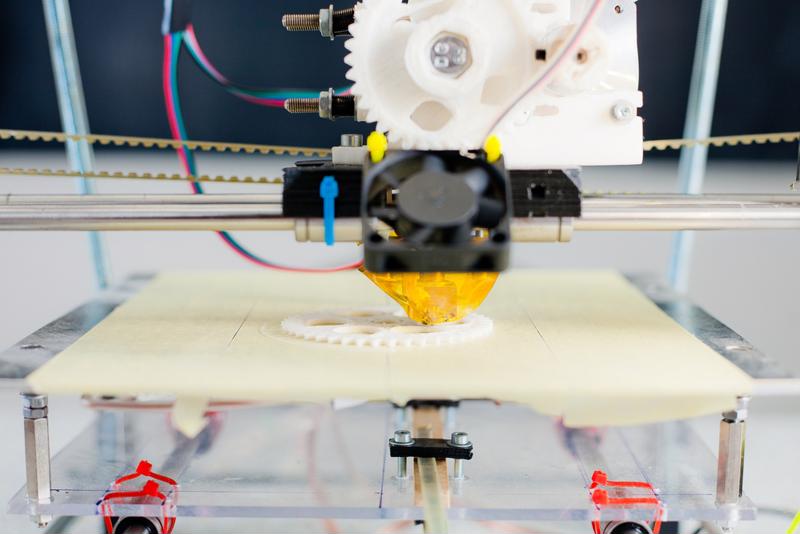Category: Electronics
4 Jan Electronics manufacturing sees growth with 3D printers
Advancements in 3-D printing change how manufacturing plants will produce materials. With the technology continuing to expand and new uses of the printers emerging on a regular basis, manufacturers have found creative ways to put the machines to use. By investing heavily in the printers, companies in all fields are seeing immediate results and improved production.
As the potential financial gain grows, the limits to which companies will go with these 3-D printers is also expanding. In November, Toshiba announced it had developed a metal printer that could deliver materials such as iron, Inconel and stainless steel 10 times faster than previous models. By creating software that allows users to modify what they are making, the printer can process complex shapes and designs to create exactly what designers have in mind. According to DigiTimes, the company is still tinkering with the prototype but hopes to have the product on the market in 2017.
The idea of printing steel was unheard of just a handful of years ago, but the rapid progress made in the field has changed all that. With more developments on the way for manufacturers, embracing 3-D printers is a necessity. The technology isn’t just for material sintering. The advancements are also changing the way electronics are made.
Use for 3-D printers expanding
The newest evolution in 3-D printing are machines that produce high-level wearable electronics, such as watches, glasses and clothing. As more buyers look to acquire items like virtual reality-supported headsets and data-tracking wristbands, businesses are realizing how important wearable electronics are to the industry. The devices are prominent in fields such as health care and athletics, and have the backing of brands like Nike and Apple.
According to IDTechEx, the wearable electronics field already generates $20 billion annually. However, the industry is set to grow at a tremendous rate, and should be worth more than $70 billion in the next decade.
In response, New York-based Graphene 3D Labs has begun creating 3-D printers that specialize in the production of wearable electronics. The company can print materials that are lightweight and flexible, which allows them to be fitted specifically in coordination with electronic technology.
 3-D printers are changing the way electronics manufacturing is done.
3-D printers are changing the way electronics manufacturing is done.“Wearable electronics is an obvious application as the electronics, sensors and conductive properties will all need to be flexible with the wearable material,” Daniel Stolyarov, the co-CEO of Graphene 3-D Labs, said to the New York Business Journal.
Wearable electronics are just one industry that has grown thanks to 3-D printers. The technology has also taken its place in other fields.
Engineers at Purdue University developed a machine that prints ready-to-use electronics, such as computer mouses. However the system, called RevoMaker, is different than most printers because it is built with a multi-directional design, meaning different parts of electronics can be constructed on their own and then put together. For electronics that need batteries or motors installed, the Purdue 3-D printer allows them to be embedded before the printing process begins.
“With a traditional 3-D printer you print on a planar print bed and the platform is fixed,” Raymond Cipra, a Purdue professor of mechanical engineering, said in a statement. “Our strategy is to replace the print bed with a laser-cut cuboid which can be rotated about an axis to provide orthogonal printing surfaces on each side of the volume.”
Cloud software to monitor it all
For manufacturing businesses hesitant to invest in 3-D printer technology or feel they are lagging behind, an optimal solution is NGIMES, a cloud-software from Atachi. The program gives companies greater flexibility and rapid responses to measure if investing in new technology is worth it.
For electronics manufacturers who have invested in 3-D printers, NGIMES can also be a great asset. From making high-tech watches to battery-controlled speakers, the printers can create products in ways technology has never been able to match before. Cloud technology helps monitor production so a company receives the maximum return on investment possible. With access to real-time information about production, manufacturing plant managers can see how well their printers are doing and what changes need to be made moving forward.
It doesn’t appear that 3-D printers are going away any time soon, as researchers keep advancing the technology forward with new innovations. Given how important the printers will be in all aspects of manufacturing, especially electronics, having a program such as NGIMES working alongside will help turn a factory floor into a more efficient and profitable workspace.
19 Aug 5 reasons to move your MES to the cloud
Small- to medium-sized businesses know the importance of keeping operations cost-effective. Whether your company is just getting started or has been in the game for years, improving your manufacturing operations is essential.
However, the challenge many people have with this notion is keeping new manufacturing processes lucrative without investing every last dime into technology. One area continuing to expand for facility operators and owners is manufacturing execution systems. More often than not, manufacturers are at least exploring the idea of how MES-based software can improve the quality of their operations. On the other hand, remaining affordable can be a serious hurdle to jump for SMBs.
This has many SMB manufacturers looking at cloud-based MES software. In many ways, working in the cloud has its benefits over standard MES software. In particular, this sophisticated system can run from anywhere and provide real-time data.
Here are five more reasons to move your MES to the cloud:
1. Consistent at a high level
SMBs tend to struggle with maintaining delivery of high quality products. Additionally, it’s even more difficult to perform these operations at a fast pace. It’s up to manufacturers to use their materials in the most effective way to drive productivity, Solutions PT reported.
“Cloud-based MES solutions drive higher and more consistent quality products.”
While this can be a challenge, cloud-based MES solutions drive higher and more consistent quality products. With real-time data, businesses are able to make in-the-moment adjustments to improve manufacturing processes. This will limit faulty or deformed products in your facility.
2. Increase flexibility
In today’s manufacturing world, it pays to be flexible in your manufacturing facility. Through MES in the cloud, you’re able to improve quality and increase visibility in your day-to-day operations. This ultimately helps you reduce costs with remote access and data processing.
Working in the cloud makes it easier for facility operators to use the data to improve manufacturing operations. Simply put, you won’t have to rely on large investments in information technology by working with an MES partner who can access, troubleshoot and assist you with all your data. This gives you more flexibility with your payroll.

3. Maintain security
Most believe traditional IT systems are the best at keeping data safe and secure. Additionally, there are a lot of misconceptions about storing data in the cloud. Sue Poremba, a contributor for Forbes, interviewed JP Morgenthal, director for Perficient, a technology and management consulting firm, about the false impressions of cloud-based software. Morgenthal said while many can publicly access the cloud, it doesn’t mean your specific firm’s infrastructure is easily breachable.
“The subsequent part of this that holds some truth is that there are not as many trained professionals with skills on how to secure cloud applications and, thus, there is a greater likelihood of a mistake in the configuration of a cloud environment,” said Morgenthal. “These mistakes are a lot more difficult to make in a private data center.”
4. Remain compliant
Compliance is another tricky task for SMBs with the number of government and industry regulations increasing. With the help of a cloud-based MES partner, you’re ensured to be up-to-date on new regulations in the manufacturing industry. MES in the cloud allows manufacturers to produce higher quality products while maintaining compliance and regulatory updates.
5. Prepared for the future
While there are numerous instant benefits to adopting your MES into the cloud, the system also helps you prepare for the future, LNS Research reported. With new trends in the market and additional software being released each year, you know you’ll be fully up to date by investing in the cloud. With the cloud, you can start a free trail to see how well MES can work for you.
